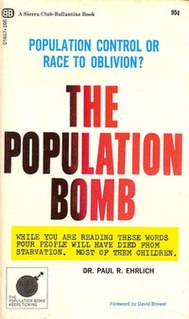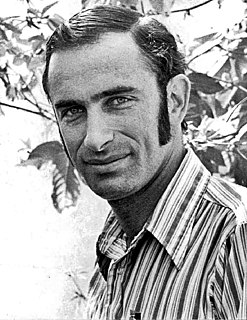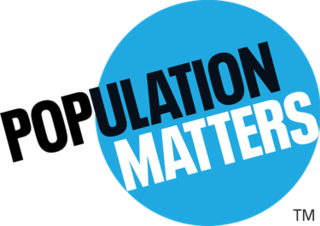
Sustainable development is an organizing principle for meeting human development goals while also sustaining the ability of natural systems to provide the natural resources and ecosystem services on which the economy and society depend. The desired result is a state of society where living conditions and resources are used to continue to meet human needs without undermining the integrity and stability of the natural system. Sustainable development was defined in the 1987 Brundtland Report as "development that meets the needs of the present generation without compromising the ability of future generations to meet their own needs". As the concept of sustainable development developed, it has shifted its focus more towards the economic development, social development and environmental protection for future generations.
The carrying capacity of an environment is the maximum population size of a biological species that can be sustained by that specific environment, given the food, habitat, water, and other resources available. The carrying capacity is defined as the environment's maximal load, which in population ecology corresponds to the population equilibrium, when the number of deaths in a population equals the number of births. The effect of carrying capacity on population dynamics is modelled with a logistic function. Carrying capacity is applied to the maximum population an environment can support in ecology, agriculture and fisheries. The term carrying capacity has been applied to a few different processes in the past before finally being applied to population limits in the 1950s. The notion of carrying capacity for humans is covered by the notion of sustainable population.

The Population Bomb is a 1968 book written by Stanford University Professor Paul R. Ehrlich and his wife, Anne Ehrlich. It predicted worldwide famine due to overpopulation, as well as other major societal upheavals, and advocated immediate action to limit population growth. Fears of a "population explosion" existed in the mid-20th century baby boom years, but the book and its author brought the idea to an even wider audience.

I = (PAT) is the mathematical notation of a formula put forward to describe the impact of human activity on the environment.
Overconsumption describes a situation where the use of a renewable natural resource exceeds its capacity to regenerate. A prolonged pattern of overconsumption leads to the eventual loss of resource bases. The term overconsumption is quite controversial in use and does not necessarily have a single unifying definition. Overconsumption is driven several factors of the current global economy, including forces like consumerism, planned obsolescence, and other unsustainable business models and can be contrasted with sustainable consumption.

The ecological footprint is a method promoted by the Global Footprint Network to measure human demand on natural capital, i.e. the quantity of nature it takes to support people or an economy. It tracks this demand through an ecological accounting system. The accounts contrast the biologically productive area people use for their consumption to the biologically productive area available within a region or the world. In short, it is a measure of human impact on the environment.

Paul Ralph Ehrlich is an American biologist, best known for his warnings about the consequences of population growth and limited resources. He is the Bing Professor Emeritus of Population Studies of the Department of Biology of Stanford University and President of Stanford's Center for Conservation Biology.
In population ecology and economics, maximum sustainable yield (MSY) is theoretically, the largest yield that can be taken from a species' stock over an indefinite period. Fundamental to the notion of sustainable harvest, the concept of MSY aims to maintain the population size at the point of maximum growth rate by harvesting the individuals that would normally be added to the population, allowing the population to continue to be productive indefinitely. Under the assumption of logistic growth, resource limitation does not constrain individuals' reproductive rates when populations are small, but because there are few individuals, the overall yield is small. At intermediate population densities, also represented by half the carrying capacity, individuals are able to breed to their maximum rate. At this point, called the maximum sustainable yield, there is a surplus of individuals that can be harvested because growth of the population is at its maximum point due to the large number of reproducing individuals. Above this point, density dependent factors increasingly limit breeding until the population reaches carrying capacity. At this point, there are no surplus individuals to be harvested and yield drops to zero. The maximum sustainable yield is usually higher than the optimum sustainable yield and maximum economic yield.

Overfishing is the removal of a species of fish from a body of water at a rate greater than that the species can replenish its population naturally, resulting in the species becoming increasingly underpopulated in that area. Overfishing can occur in water bodies of any sizes, such as ponds, wetlands, rivers, lakes or oceans, and can result in resource depletion, reduced biological growth rates and low biomass levels. Sustained overfishing can lead to critical depensation, where the fish population is no longer able to sustain itself. Some forms of overfishing, such as the overfishing of sharks, has led to the upset of entire marine ecosystems. Types of overfishing include: growth overfishing, recruitment overfishing, ecosystem overfishing.

Environmental degradation is the deterioration of the environment through depletion of resources such as quality of air, water and soil; the destruction of ecosystems; habitat destruction; the extinction of wildlife; and pollution. It is defined as any change or disturbance to the environment perceived to be deleterious or undesirable.

A steady-state economy is an economy made up of a constant stock of physical wealth (capital) and a constant population size. In effect, such an economy does not grow in the course of time. The term usually refers to the national economy of a particular country, but it is also applicable to the economic system of a city, a region, or the entire world. Early in the history of economic thought, classical economist Adam Smith of the 18th century developed the concept of a stationary state of an economy: Smith believed that any national economy in the world would sooner or later settle in a final state of stationarity.

Human impact on the environment refers to changes to biophysical environments and to ecosystems, biodiversity, and natural resources caused directly or indirectly by humans. Modifying the environment to fit the needs of society is causing severe effects including global warming, environmental degradation, mass extinction and biodiversity loss, ecological crisis, and ecological collapse. Some human activities that cause damage to the environment on a global scale include population growth, overconsumption, overexploitation, pollution, and deforestation. Some of the problems, including global warming and biodiversity loss, have been proposed as representing catastrophic risks to the survival of the human species.

Environmental vegetarianism is the practice of vegetarianism when motivated by the desire to create a sustainable diet that avoids the negative environmental impact of meat production. Livestock as a whole is estimated to be responsible for around 15% of global greenhouse gas emissions. As a result, significant reduction in meat consumption has been advocated by, among others, the Intergovernmental Panel on Climate Change in their 2019 special report and as part of the 2017 World Scientists' Warning to Humanity.

Human overpopulation is the concept of a human population becoming too large to be sustained by its environment or resources in the long term. The idea is usually discussed in the context of world population, though it may also concern regions. Human population growth has increased in recent centuries due to medical advancements and improved agricultural productivity. Those concerned by this trend argue that it results in a level of resource consumption which exceeds the environment's carrying capacity, leading to population overshoot. The concept is often discussed in relation to other population concerns such as demographic push and depopulation, as well as in relation to resource depletion and the human impact on the environment.

Population Matters, formerly known as the Optimum Population Trust, is a UK-based charity that addresses population size and its effects on environmental sustainability. It considers population growth as a major contributor to environmental degradation, biodiversity loss, resource depletion and climate change. The group promotes ethical, choice-based solutions through lobbying, campaigning and awareness-raising.

Sustainability is a societal goal that broadly aims for humans to safely co-exist on planet Earth over a long time. Specific definitions of sustainability are difficult to agree on and therefore vary in the literature and over time. This concept can be used to guide decisions at the global, national and individual level. In everyday usage of the term, sustainability is often focused on the environmental aspects. The most dominant environmental issues since around 2000 have been climate change, loss of biodiversity, loss of ecosystem services, land degradation, and air and water pollution. Humanity is now exceeding several "planetary boundaries".
In environmental science, the concept of overshoot means demand in excess of regeneration. It can apply to animal populations and people. Environmental science studies to what extent human populations through their resource consumption have risen above the sustainable use of resources. For people, "overshoot" is that portion of their demand or ecological footprint which must be eliminated to be sustainable. Excessive demand leading to overshoot is driven by both consumption and population.
The Center for Population Economics is a research center at the University of Chicago Booth School of Business. The work of the CPE is funded primarily by the U.S.'s National Institute on Aging of the National Institutes of Health.
Agricultural expansion describes the growth of agricultural land especially in the 20th and 21st centuries.

Sustainable population refers to a proposed sustainable human population of Earth or a particular region of Earth, such as a nation or continent. Estimates vary widely, with estimates based on different figures ranging from 0.65 billion people to 98 billion, with 8 billion people being a typical estimate. Projections of population growth, evaluations of overconsumption and associated human pressures on the environment have led to some to advocate for what they consider a sustainable population. Proposed policy solutions vary, including sustainable development, female education, family planning and broad human population planning.















